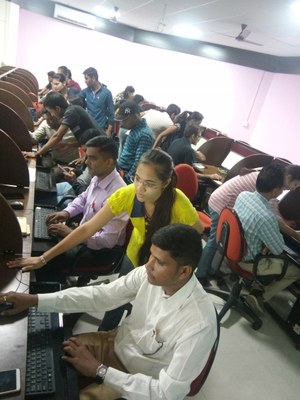SVG Translation Workshop at KBC North Maharashtra University
Background
During the edit-a-thons and thematic workshops, the need for images in Marathi was realised. Many articles on health and science have images with labels in English. The issue was discussed with few institutions. KBC University came forward to start the activity under this campaign.
Objectives
- Orientation of Wikimedia projects
- Localisation of SVG images
- Commons upload policies and process
Facilitators
- Krishna Chaitanya Velaga -- User: KCVelaga
- Subodh Kulkarni, CIS-A2K --Subodh (CIS-A2K)
- Prof. Manish Joshi, SOCS KBCNMU, Jalgaon -- Joshmanish
- Dr. Snehalata B. Shirude, SOCS KBCNMU, Jalgaon --Snehalata Shirude
Agenda
- Introduction to Wikimedia projects, Marathi Wikipedia, Commons
- Account creation, basic editing skills
- Copyrights, Commons upload process
- Graphics images, types of formats, features
- Installation of fonts, Inkscape
- Resources for translation, verification before uploads
- Selection of images, tags, categories for upload
- Using translated images in local Wikipedia
Report
As the participants were not aware of Wikimedia projects, the first two sessions dedicated to an introduction to various projects. The participants opened accounts on a smartphone and created user pages after logging in on computers. They were introduced to basic skills in Wikipedia editing, giving references/wiki links and adding images from Commons. The Commons platform was explained in detail. The missing images in Marathi language articles and Commons as well were shown. The discussion on these topics resulted in understanding the need for SVG translation exercise.
The next session was to download and install the necessary software on each computer. The participants installed Google Input Tools for Marathi typing and also Inkscape. Before translating images on Inkscape, the students first practised Marathi typing on their sandboxes. After this, the main graphics sessions were conducted. Krishna explained various types of formats, differences between raster and vector graphics, the importance of SVGs and actual SVG file translation process. He demonstrated the process for images with different difficulty levels. They were introduced to resources available as a part of the campaign for SVG translation and necessary techniques. The usage of various online resources like encyclopedia and thesaurus available was also explained. The images were selected and working tags were applied by the participants. The faculty facilitated the process of work distribution among the students. The participants were able to upload 100+ images on the first day.

Pictured above: Students from Day 1 helping others on Day 2 (Picture by Subodh Kulkarni)
On Day 2, around 20 participants newly joined the workshop. This group comprised of teachers, journalists, doctors, and other enthusiastic citizens. Active students from Day 1 facilitated the training of this new batch. Having conducted a session on the previous day greatly helped to facilitate this session easily. The experienced teachers and citizens helped others to get correct translations and terms. This boosted the speed of the work. The images were also used in the articles on Marathi Wikipedia.
With the help of science teachers, the images were verified before uploading to Commons. Due to active participatory work on the second day, the total images crossed 200 mark. The students continued to contribute till last day of campaign i.e. 31 March. At the end, due to consistent work Marathi category reached the highest number with a total of 357 images among all Indian languages. The workshop and further work was well organized and motivated by Prof. Manish Joshi and Prof. Snehalata Shirude from Computer Science department.
Link to the Wikipedia page report here


